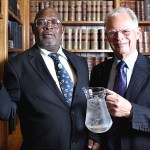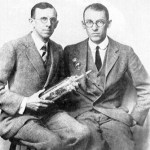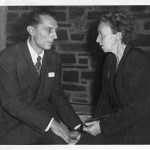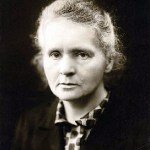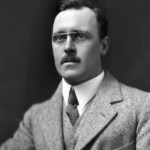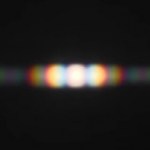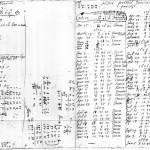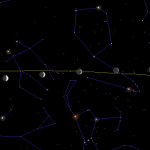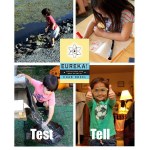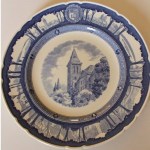Last week I mentioned that I was going to be on the radio twice, talking about Eureka: Discovering Your Inner Scientist. I was right about one of those:
-- My appearance on Voice of America's Science World ran over the weekend, and there's a link to the program up now. I can't figure out a way to link directly to the episode (other than hotlinking to the download, which seems uncool), but it's the December 19, 2014 episode. My bit starts about 16 minutes in.
-- The other radio thing I mentioned last week was an appearance on WAMC's Roundtable. I did, in fact, drive to Albany to record this…
Eureka
Another weekend day, another story I'm going to outsource a bit. In this case, to the original scientist, who at the time of his discovery was a 13-year-old schoolboy in Tanzania:
In 1963, when I was in form 3 in Magamba Secondary School, Tanzania, I used to make ice-cream. The boys at the school do this by boiling milk, mixing it with sugar and putting it into the freezing chamber in the refrigerator, after it has first cooled nearly to room temperature. A lot of boys make it and there is a rush to get space in the refrigerator.
One day after buying milk from the local women, I started…
We're going to depart from the chronological ordering again, because it's the weekend and I have to do a bunch of stuff with the kids. Which means I'm in search of a story I can outsource...
In this case, I'm outsourcing to myself-- this is a genuine out-take from Eureka: Discovering Your Inner Scientist, specifically Chapter 2, which tells two stories from the career of Luis Alvarez, who I've talked about before in the context of his experiment to x-ray one of the pyramids at Giza, and the time I wrote him a letter when I was nine about his theory that an asteroid impact killed the dinosaurs…
As I endlessly repeat, I'm an experimentalist by training an inclination, so I especially appreciate stories about experimental science. There's something particularly wonderful about the moment when an experiment clicks together, usually after weeks or months of hard, frustrating work, when things just keep breaking.
Of course, sometimes, breaking stuff can be a Good Thing.
Possibly my favorite story from the development of quantum physics involves just such an occasion, around 1924, when Clinton Davisson and Lester Germer at Bell Labs were trying to characterize a nickel surface by bouncing…
Given that I am relentlessly flogging a book about the universality of the scientific process (Available wherever books are sold! They make excellent winter solstice holiday gifts!), I feel like I ought to try to say something about the latest kerfuffle about the scientific method. This takes the form of an editorial in Nature complaining that Richard Dawid and Sean Carroll among others are calling for discarding traditional ideas about how to test theories. Which is cast as an attempt to overthrow The Scientific Method.
Which, you know, on the one hand is a kind of impossible claim. There…
Two radio appearances upcoming as I continue to promote Eureka: Discovering Your Inner Scientist:
-- Tomorrow, Friday the 19th, I'll be going down to WAMC around 11am to be on Roundtable, talking with Joe Donahue. This will be live, but fairly short. This is available on a whole host of stations in the not-The-City part of New York, and streaming over the Internet.
-- A couple of days ago, I recorded some stuff for Voice of America's Science World, which ought to air this weekend. This is available all over the world, and, again, streaming over the Internet.
Publicity marches on...
The winter solstice holidays are a time for family and togetherness, so building off yesterday's post about the great Marie Skłodowska Curie, we'll stay together with her family. Specifically her daughter Irène Joliot-Curie and her husband Frédéric. The Joliot-Curies are possible answers to a number of Nobel Prize trivia questions-- only mother and daughter to win, one of a handful of married couples, etc.-- but the scientific story about them that I find most fascinating is that their Nobel was for the third thing they did that could've earned them the prize, after they just missed out on…
There's no way I could possibly go through a long history-of-science blog series without mentioning the great Marie Skłodowska Curie, one of the very few people in history to win not one but two Nobel Prizes for her scientific work-- if nothing else, Polish pride would demand it. She made a monumental contribution to physics through her work on radioactivity (and through being nearly impossible to kill-- while her work on isolating radium made her ill for many years, she outlived an amazing number of her assistants...), and there are a lot of great stories about her.
This series is partly…
"You wanted to see me, Herr Professor?"
"Hans! Yes, come in, come in. Just going over the account books. Frightful amount of money going out of this place."
"Well, radium is expensive..."
"Ha! Oh, and speaking of which-- here's one of the sources. Absent-mindedly dropped the fool thing in my pocket last night when I locked up. Terrible habit, I really must work on that. Had a drawer full of the things in Montreal..."
"Thank you. And you wanted to see me about...?"
"Oh, yes. We have a new student, Hans, and I'd like you to put him to work on the gold foil project."
"Shouldn't he have his own…
Over at Medium, they've published a long excerpt from Eureka: Discovering Your Inner Scientist, that gives a good flavor of what the book's really like. It's about how the process for solving hidden-object games like the classic Where's Waldo books is comparable to the process used by Henrietta Leavitt to revolutionize our understanding of the universe:
There are multiple web sites and academic papers devoted to computer algorithms for locating Waldo within Handford’s drawings, using a variety of software packages, and these are impressively complex, running to hundreds of lines of code and…
"...and take care that all the signatures go in the right way round, eh, James? I was able to soothe Mr. Dance last time, but if another copy comes back to be rebound, M. de la Roche will put you out."
"Yessir."
"A little more care, there's a good lad. Run home, now, we'll see you in the morning." The apprentice scurried off.
The journeyman bookbinder checked again that the shop door was securely closed, pulled his coat tighter against the March chill, and turned to make the short walk to his own meagre rooms. Stuffing his hands in his pockets, he felt the folded pamphlet advertising tonight…
Scientific controversies aren't always settled by a single dramatic experiment, but it's a lot of fun when they are. It's even more fun when they can be carried out with, as the author put it, "without any other apparatus than is at hand to every one."
I'm speaking in this case of the famous "double slit" experiment of Thomas Young, though if you want to be really picky about it, he didn't originally do it with a double slit, but a single "slip of card" that divided a beam of sunlight. Some distance away from the card, the overlapping light from either side of the card combined to produce a…
A few items for Sunday morning:
-- First and foremost, in just a few hours from now, I'll be signing books at the Open Door. If you're in Quebec or central Pennsylvania, you better leave now; Boston or NYC, you can have a cup of coffee first. Farther than that, you might try calling them around 11am ET to see if they'll ship you one...
-- The Albany Times Union did a short Q&A with me about the book. This ran Thursday, apparently, but didn't show up on Google, so I only found it this morning when I went to the Times Union site directly.
-- There's a good, thoughtful review in the…
Speaking of the timing of astronomical phenomena, as we were yesterday, the timing of celestial bodies was the key to the first demonstration of one of the pillars of modern physics, the fact that light travels at a finite speed. This actually pre-dates yesterday's longitude discoveries, which I always forget, because it seems like it should've been a later development.
The first really convincing demonstration that light doesn't cover arbitrary distances instantaneously dates from 1676, and was the work of the Danish astronomer Ole Rømer. Under the direction of Giovanni Cassini at the Paris…
One of the questions from a caller when I was on the "Think" show was about how to keep kids interested in science. As I said, the issue isn't so much creating in interest as working to not squelch the interest that's already there. Taking kids to cool places like zoos and science museums is a great way to do that, and just generally encouraging them to ask questions and try things out.
But if you'd like some more specific gift ideas, here's a selection of science-y things that SteelyKid and The Pip enjoy that you might try out on other kids of your acquaintance:
-- Magna-Tiles These. Are.…
Returning to our mostly-chronological ordering after yesterday's brief excursion, we come to one of the great problems of the 1700's, namely determining the longitude at sea. Latitude is easy to find, based on the height of the Sun at noon-- we told that story last week-- but longitude is much trickier. Thanks to the rotation of the Earth, the best way to measure longitude is by measuring time-- if you know what time it is where you are, and what time it is at some reference point (now established as Greenwich, UK), the difference between those times tells you the difference in longitude.…
Two quick notes:
-- In a little more than half an hour Buttercup will marry Humperdinck I'll be talking about Eureka on talk radio in Ireland. This was put together very quickly, thus the short notice.
-- I'll be signing books this Sunday, the 14th, at The Open Door Bookstore in Schenectady. If you're in the area, please stop by; if you're not, and would like a signed book, you might give them a call and see if they'll ship you one. I'm happy to sign and personalize extra copies for that sort of thing. They make great gifts for all manner of winter solstice holidays...
Last week Kate pointed me to this post about heroic stories of science saying "This seems relevant to your interests." And, in fact, a good deal of the post talks about Patricia Fara's Science: A Four Thousand Year History, the Union library's copy of which is sitting on my desk, where I had looked something up in it just that morning. (Specifically, the part where Fara notes that the distinction between "science" and "technology" is largely a class-based fiction, dividing high-status philosophers from grubby practical mechanics.)
There are a bunch of things going on in this, and most of them…
I've been trying to keep to a roughly chronological ordering of these stories, but this slow-motion snow storm that was waiting to greet us on our return from Florida made the schools open on a two-hour delay today, which eats the time I usually use for blogging and books stuff. So I'm going to jump forward three hundred years, to a story that I can outsource.
To set the stage, in the aftermath of WWII, Richard Feynman took up a faculty job at Cornell, but between working on the Manhattan Project and the death of his beloved wife, he found that he was completely burned out, and not able to do…
Yesterday, I drove through the slush to Albany to do an appearance on KERA radio's "Think" from a studio there. The audio is at that link.
It was a bit of a strange experience, because I drove to a place to do the interview in a radio studio, but I was the only one in the room, taking questions from a disembodied voice. I enjoyed it, though, and the audio quality is a lot better than you would've gotten from even a land-line phone. This was a live show, including some call-in questions, and that always has a working-without-a-net quality that is kind of exciting. I got in a bunch of stories…
